
In January of 2010 I found myself making a 15-minute, fully animated and voice-overed business presentation in Powerpoint.
It took me ten days of researching, processing, drawing, animating and recording. I find Powerpoint grueling at best, and this job proved to be exceptionally grueling. I needed something to stay sane, and my eye fell on the Chip'n'Dale's Rescue Rangers DVDs on the shelf.
I had seen the series back in early 1990s, and got the DVDs back in 2006 out of sentimentality; I had watched a couple favorite episodes, and put the discs away. Now they found a good use: whenever my thoughts began to get murderous from Powepoint overdose, I launched another cartoon for a 20-minute break.
The presentation was delivered on time, but as a side effect I had gulped about 50 CDRR episodes in ten days.
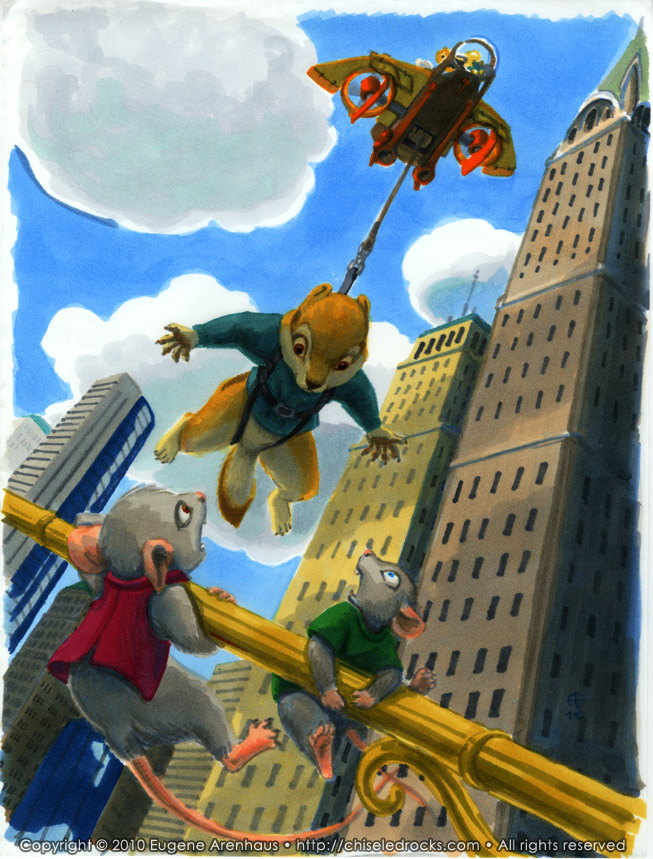

Chip rescues two mice. By cartoon logic, whenever you fall off a skyscraper, you end up on a flag stick. And then the Rangers have to get you off it.
Two things had become evident to me. Number One, the show had been good, but suffered from too-short episodes that prevented more in-depth storylines, and from frustrating toying with almost-adult themes. There could be so much more done with this team of characters and setting, but the show had been constantly trying to appeal to a much younger audience and so it balanced on the border between saccharine and mature. Some of the episodes touched cults, addiction, espionage, self-fulfilling prophecies. But then it all reset again, never quite reaching the level of "The Rescuers". There is so much more to be done with this setting and this team of characters! But that was not the reason for this here thing.
That had been the Number Two: I was noticing the differences in various animation shops' handling of the characters, and quickly realized that Walt Disney Animation Japan was reading the model sheets differently from the rest. The model sheets for these characters do not list the real structures; just the sample poses. That apparently was not enough for many of the animators, and some shots in the show display rather bizarre anatomies and movement. But someone at WDA Japan had known how to parse the sheets and constructed the motion in a much freer way. When I noticed that they were clever enough to put the hip joint on the rodents where it belonged, avoiding the model sheet's trap of giving them shortened legs, a thought crept up my spine: I could probably make them more realistic critters, instead of cute cartoons.
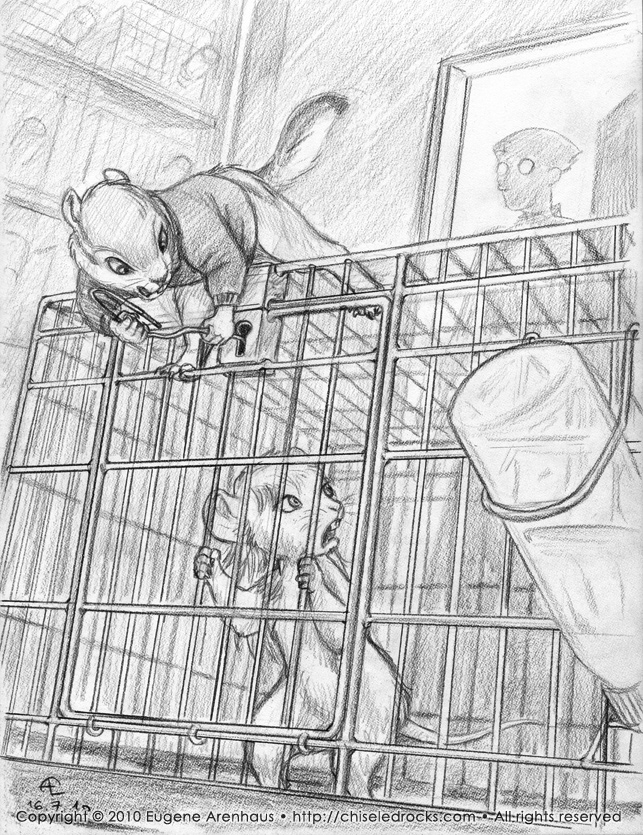
The real Mouseverse is full of dangers like laboratories in which human scientists never think twice of mouse rights.
I did not rush into attempting it. I had actually tried to redesign the RR team some years before, and discovered then that Monty and especially Gadget were insurmountable obstacles. Monty was too cartoony. Gadget was much worse: too humanoid. Puzzlingly humanoid in a team of mice. Unless I could somehow convey the same character in a mouse, it all would be wasted work.
I combed the Web in search of more production art, possibly early sketches of the team, or alternative model sheets. I found none; presumably they are hidden in the same place as the original reels of the show. What I found was a lot of fan speculation, and a lengthy interview of Tad Stones. And in it, someone had asked the same question: why was Gadget more humanoid than the rest of the team?
Stones' answer made something click in my head. Stones had replied that from his point of view, Gadget was never meant to be humanoid. The odd look resulted from production constraints and some technical snafus, like the color process making her look skin-colored, instead of original off-white. But she was designed as a mouse; she simply got filtered through the labyrinths of offshore animation. So there was no reason I could not make her a mouse.
I took a piece of paper, quickly doodled a mouse face in one corner, and Gadget from the show in the other, and set out to find a recognizable compromise. Within fifteen minutes, I got this:

I had refined the design later, but even this first attempt was unmistakably Gadget. I barely believed that it could be done; I played with the figure, testing what it could do. It could do anything. A four-leg run was now possible, something that Gadget hardly ever did in the show. The goggles could fit without Mickey-ears fudging. It could likely be done in 3-dimensional CG, even. And the character conveyed!

The "straight" figure in the middle of bottom row is a proportions test. Human proportions do not work for rodents; I have to measure the body and the hind legs separately.
I was encouraged and set out to design the rest of the team. The chipmunks had been easy, though I got rid of the Disney look quite soon, and reworked the costumes. Especially Dale gets a fashionable mohawk, a skateboard, and a black shirt with every symbol in existence, instead of little flowers. Chip now wears a turtleneck sweater, but you just know he still keeps the old hat somewhere in a drawer.

Starting out quite close to show design, Chip becomes more feral-like, but still retains his intense focus. The chipmunks have been given somewhat divergent facial markings, to better match their personalities: Chip's face painted with focused alertness, Dale's with freedom of cares. And both get new wardrobe.
Monty just flowed onto the page, after that; the first attempt was a lucky guess.

Later on, I remembered to reverse the pilot's goggles into correct position.
So I drew a couple of sketches for the complete team lineup, and made an illustration in color pencil. That's the one at the top of this page.
The personalities stay almost exactly the same, since the team works so well. Chip is the motivator, the athlete and the would-be detective (although his actual logic and attention are surpassed by Gadget's, he has far more drive and focus). The Rangers are his passion; without him, there would be no focus to their activities. Dale is the relaxed dude, who relies on his supernatiral luck more than on any skills; he still loves comic books, science fiction, and sweets. He has picked up skateboarding and thinks he is cool. He also copilots the Ranger Wing. He is capable of the same acrobatics as Chip, but is less fit, because he is lazy and eats too much sugar; without him, the team would lose a lot of levity and lucky chaos he induces. Gadget is the quiet mechanical genius, who can make things work, and provide the scientific expertise in investigations; she is fit and agile, but not particularly physically able. But she is much more without realizing it herself - without her, the team would fall apart. She is the glue that holds the other four together. Monty is the strong man and fatherly guy; he pilots the Ranger Wing, cooks, and provides a strong arm when it is needed; he is not too agile, but amply compensates with raw force. Without him the team would lose their raw power and strong back. Zipper is still the silent bug with a big heart, the indispensable lookout and messenger.
I had continued to explore the idea in warm-up sketching sessions and exploratory doodles. This redesigned Ranger team could tackle more serious things, in a world where humans had not been happily oblivious oafs never noticing mice flying about in tiny helicopters. In fact, one of the most obvious themes for a project set up in this version of CDRR would be the interaction of Mouseverse with the human world. You'd have bold young generation like the Rangers that is gradually losing all caution, and the old guard grumbling about it, and much more nefarious human villains than the bumbling mad professor. I'd relocate the Rangers headquarters out of the park (right, no one ever notices the lit-up runway on a very prominent singleton tree) to a more remote place like the airplane junkyard. I tried to imagine what would Gadget's workshop really be, and how would a sensibly designed Ranger Wing work. I also did some test illustrations just for fun. What follows is the bulk of the work done for this concept.


Gadget seems to have gotten carried away on her newest project.It should work!

Checking on the police station remains an important part of the Rangers' routine. At least some of the Rangers, that is.
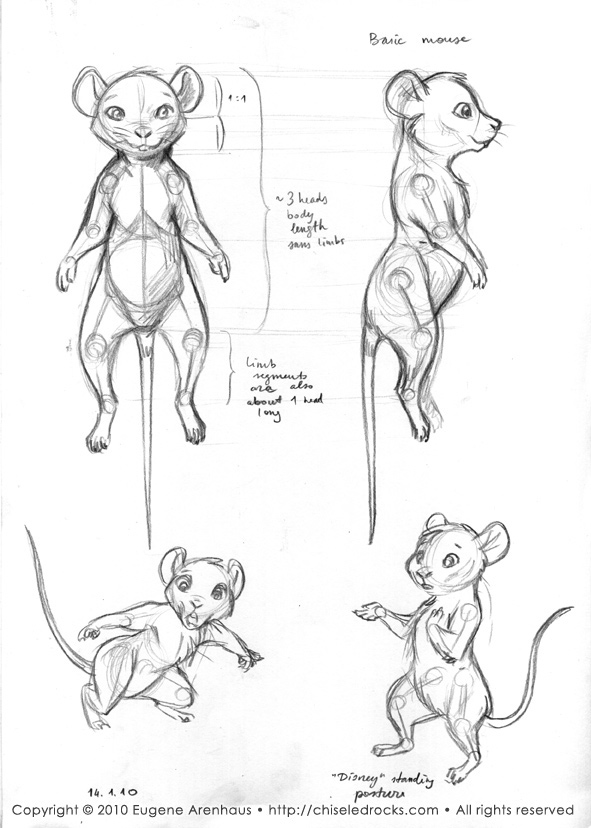
A sketch of a basic mouse model, working out formal rodent proportions for this concept.

An assortment of mostly feral rodents. Exploring how the basic model works in various poses.
The Ranger Wing
The less cartoony Rangers called for a less cartoony Ranger Wing. The original one was a nice concept, but it would never work: to begin with, its pushing props were turned in the wrong direction in hover mode. I soon abandoned the "junk" Ranger Plane, and focused on making the Wing work. This is the Rangers transport as Gadget would have built it given proper tools, parts and materials.

The Wing is probably about two feet long, and weighs a few kilograms. I used some small details, like the screws, to make its scale evident. It flies on twin kilowatt-plus electric motors salvaged from model airplanes, and its weight is mostly lithium batteries. The batteries are everywhere, even under the seats. It has two principal modes: fast flight and hover / landing, converting from plane to helicopter. It would provide much less hover time than cruise time, but a VTOL craft would be a necessity for the Rangers. I redesigned the wings and motors, so while the silhouette remains reminiscent of the original show Wing, this redesign would actually be controllable and much more stable. (It could almost work in reality, I think.) The whole thing is balanced between the motors while hovering, and additional balance would be provided by moving part of the battery pack back and forth. As a tribute to the old Ranger Plane, and to make the design more versatile and interesting, I kept the articulated "legs".
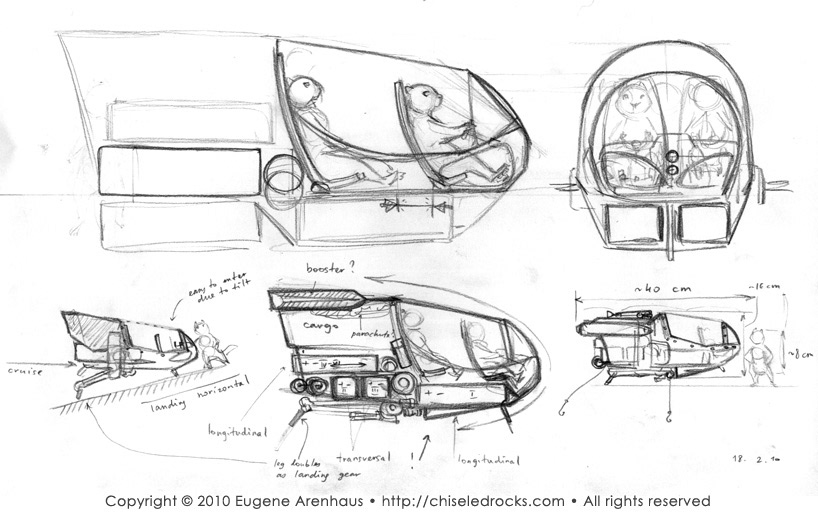
The first inklings of the current design. Figuring out the configuration of the cockpit. The "dipped" landing configuration, and a movable battery for balance are already there.
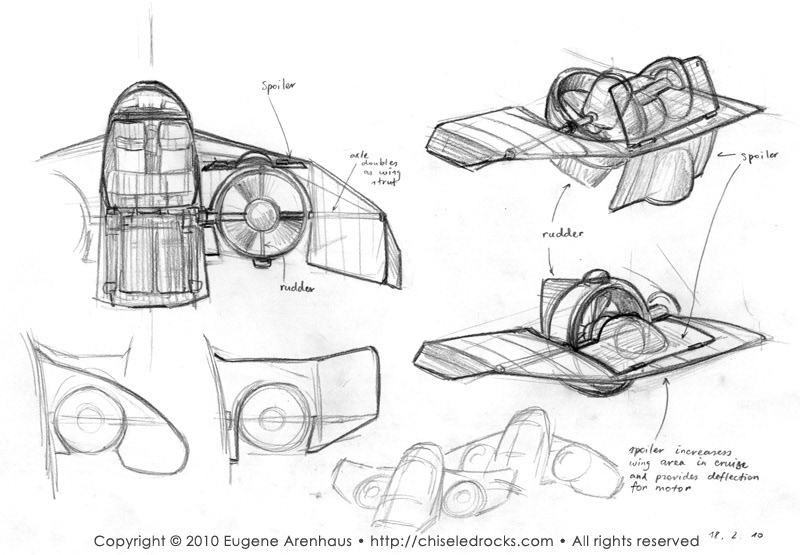
Wing configuration. This is the first appearance of the spoilers that close to form the wing middle and the motor baffles, and open to create apertures for hover.

The cockpit is still too reminiscent of the "big" aircraft, but the overall shape is already visible. Some early designs for the instrument panels and controls.

Some concepts for the cockpits, using found objects like a small hexagonal marmalade jar, or a mylar strip. In the end, a simple plastic dome wins.
In the show, Gadget pilots the plane and the Wing, but that makes her almost a super-character: she can do everything the others can, and with more motivation she'd probably be able to do the whole team's work! I'd rather have Monty be the pilot, taking advantage of his classical pilot's helmet. Chip and Dale would alternate as copilots, especially Dale - that would give him a more essential role in the team, and a good deal of careless flying! Gadget can focus on building things. It's not that she is a bad pilot, she is just a bit scatter-minded...

A concept for a single-mouse superlight aircraft, the Flying Squirrel.
Gadget's workshop


Gadget uses an X-acto knife attached to isoelastic arm.
Gadget's workshop was barely seen in the show. In the couple times it had been on screen, there had been barely any visible indication that it was a workshop: a mere generic room within the tree, with some toy cubes and spools. But if she works on such ambitious projects, she'd need space and tools. And since she's three inches tall, she'd find it a great challenge to get tools made for her size. She'd adapt humans' miniature tools and even full-size ones, and make other tools herself. Her workshop should be huge compared to mouse scale, probably multi-level, and full of strange and clever contraptions she uses to produce her inventions. She'd use miniature power tools, small hand tools adapted for her size with two-handed grips and isoelastic weight-reducing holders, all kinds of hoists, adapt human hand tools for powered action and rig her machinery with clever remote controls - and her tools would still dwarf her. The result would probably seem intimidating to the other Rangers, but she herself would be in her element there.
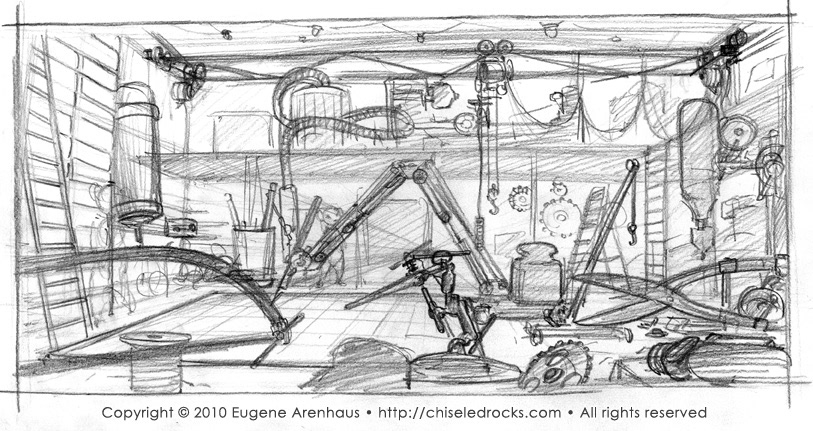
A general view of the workspace. Cranes are featured prominently. A mezzanine runs along three sides. The left wall hosts storage (matchbox drawers and a can of lighter gas). The right side is filled with powered tools. The open space in the middle is the main workspace, it hosts an isoelastic manipulator adapted from an engineer's lamp arm, which allows Gadget to work with big tools.

Some more views of the workshop from various angles. These are private brainstorming sketches, rather than presentation drawings; they are done in my "shorthand".

Some of the tools Gadget could use. Many of these are actual tools used in small-scale work. On the right, there are assorted rigs that adapt human-size tools to Gadget's use. Note the standard motors, gears from Meccano sets, control levers and buttons set into the floor - they are regular human-size microswitches, Gadget would push them with her foot.

A rough idea for the workshop construction. The whole thing is indoors, probably hidden in some old airplane hull, so its ceiling is tarp and its walls are cardboard on Meccano strut frame. The main purpose is keeping the light and noise from spilling out, and support for the big railed crane that runs overhead.

A very quick rough of how the workshop's floor plan may be arranged.
To be continued..?
This is about where I mothballed the project. Reimagining such things is fun, but unless Disney picks it up, there is little hope for anything to come out from this particular one. :)
Still, one might hope...
A version of the same page with bigger images and two pictures omitted to keep the general rating can be found here: http://chiseledrocks.com/feralrangers/fr.htm


